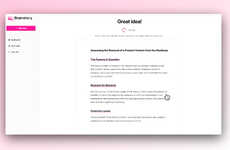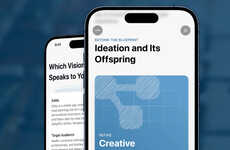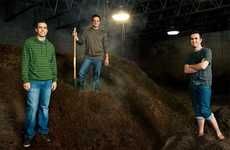Senduran Bhakthakumaran — March 26, 2012 — Business
References: newscertified & thecoynepartnership
Shawn T. Coyne is a leader in innovative thinking and has developed an in-depth knowledge of strategic consulting and line management over a span of 25 years working at firms such as McKinsey & Co. and Procter & Gamble. With his brother Kevin P. Coyne, he co-founded The Coyne Partnership, Inc., and co-wrote 'Brainsteering: A Better Approach To Breakthrough Ideas.' He has worked as the Senior Managing Principal and CAO of Zyman Group, an internationally recognized marketing consulting firm and is also a co-founder and CEO of Connexxia LLC, known for communication services. His breadth of business knowledge and vast experience has built him a career that has enabled him to pass on valuable lessons to a wide variety of officials.
Trend Hunter had the chance to ask Shawn T. Coyne some questions about innovation, inspiration and the future.
13 Questions with Shawn T. Coyne
1. How did you and your brother and co-author Kevin, get involved in promoting the generation of breakthrough ideas? What motivates you to continue?
We’ve always been fascinated by breakthrough ideas – even as little kids, we invented a contraption to help people playing vinyl record albums skip over the songs they didn’t like and go straight to their favorite ones (and that was over 20 years before CDs were invented!). As adults, we became business consultants, and we’ve spent most of our professional lives helping clients come up with ideas they’d never thought of before.
And here’s what motivates us to continue: In today’s business environment, where competition continues to become more global and structural advantages like sheer scale continue to erode, the most powerful and sustainable source of future prosperity is having more and better ideas. For example, Apple’s success over the past decade hasn’t been caused by its scale – it’s still far smaller than many other high-tech companies, with fewer employees, smaller capital budgets, etc. – it’s been caused by simply having more and better ideas than anyone else in its field.
2. What is the best way to create an infectious idea, product, or service?
I’ll tell you what it’s not – it’s not traditional brainstorming, which is the way that most people have been taught. In fact, decades of research have shown scientifically what most people have also experienced personally, which is that brainstorming is both an ineffective and inefficient way to create breakthrough ideas.
Brainstorming, like its name implies, is a lot like a lightning storm – it involves a tremendous amount of energy, but only rarely produces anything productive. The key is to take all that energy and steer it in a more productive direction by providing just enough structure to focus an individual’s or group’s thinking – and that’s exactly what we help people and organizations to do with our approach to ideation, which we call brainsteering.
3. What are the key principles that help make brainsteering useful in developing innovative ideas?
There are two key principles: (1) Ask The Right Questions, and (2) Better Orchestrate The Process.
Asking The Right Questions involves focusing your thinking and looking at your ideation problem from a different angle than you ever have before. For example, instead of simply wondering, “How can we increase profits at our company?” – at which point the mind reels with possibilities, doesn’t know where to focus, and wears out quickly – ask yourself a more focused question like, “What’s the biggest hassle customers face when using products/services in our category, and how could we eliminate that hassle?”
Better Orchestrating The Process involves leveraging the ways that human beings naturally think and work together in problem-solving situations. For example, if you’re doing a group ideation session, let social norms work for you by taking the usual large group of 20 people – where three pushy people typically dominate the conversation while 17 people sit idle, saying nothing – and breaking the group down into five smaller sub-groups of four people each, where social norms make everyone feel much more comfortable speaking up. In our experience over the past 14 years, we’ve found that the same total number of people, working for the same total length of time, usually come up with at least five times as many ideas.
4. Do you need a culture of innovation to create something that is cool?
It certainly helps!...but it’s not necessarily required. I’d tell people that if the organization you work in has a culture of innovation, thank your lucky stars for that supportive atmosphere and leverage the talent and energy of your colleagues for all it’s worth to help you create cool things – but even if the organization doesn’t have a culture of innovation, don’t give up. Throughout history, a lot of the world’s coolest ideas have been created by a single, dedicated individual – and if you continue to strive relentlessly for innovation, you may soon find that you’ve not only created several cool ideas, you’ve also begun to change the culture of your entire organization by setting an example for others.
5. What are the most important trends you see in innovative thinking?
The two biggest trends I’ve seen lately are (1) the increasing degree to which senior leaders are expecting their organizations to be innovative on a consistent and ongoing basis (versus being satisfied with a few big ideas each year), and (2) the increasing degree to which innovative thinking is now expected from every member of an organization (versus being expected from only top managers, or from people in certain departments). The combination of these two trends makes it more important than ever for each of us to build and leverage our innovation skills if we want to get ahead.
6. How do you define a trend?
The dictionary defines a trend simply as, “the popular taste at a given time,” but I wish we’d all shoot for a higher standard than that. I’d like to define a trend as, “the positive evolution of popular taste at a given time with respect to something important”. By aspiring to this higher standard, we’d all spend less time following the latest exploits of the Kardashians and more time following the lead of all those people who are trying to solve the world’s real problems!
7. How do you define cool?
When something grabs both my intellect and my emotions at the same time – and especially when it makes me say, “Wow, I wish I’d thought of that” – that’s something I consider cool.
8. How significant are the topics of trend spotting and cool hunting in the world of brainsteering?
Trend spotting and cool hunting are highly significant in the world of brainsteering. The goal of brainsteering is to help people come up with breakthrough ideas – leading edge ideas that are new to them and their organizations, and sometimes new to the entire world – and both trend spotting and cool hunting are great ways to keep up with what’s on the leading edge and keep your mind pushing forward.
9. What are your ambitions for The Coyne Partnership?
We really have only one ambition for The Coyne Partnership: to help people everywhere come up with ideas they’ve never thought of before, whether that involves inventing new products or services, improving current business processes, creating a great ad campaign, or simply figuring out how to give the perfect birthday gift to their favorite aunt. That’s why we’ve spent the past 14 years researching the subject of innovation and developing our brainsteering approach, and why we decided to write our book. It’s been a blast hearing from people all over the world who have enjoyed the book and put its principles to use in their own lives.
10. What is an example of a time where you have thrown away an existing idea to force yourself to find something new?
We do it all the time! For example, we’ve asked ourselves, “What if Client CEO X, who absolutely personifies his company to everyone inside and outside the organization (and even stars in his company’s TV commercials), got hit by a truck tomorrow? Then what?” Another time, we told ourselves, “Now that we’ve helped Client Company Y come up with $Z million worth of cost savings ideas, let’s assume for a minute that every one of them gets disqualified for one reason or another (e.g., because the union won’t agree to them, or the client can’t find a buyer for that underutilized factory). Then what?”
11. How do you reset yourself to be creative? Do you have any rituals?
This is embarrassing to admit, but whenever I need to be creative and nothing else is working, there’s a certain easy chair in our family room that I go home and sit in, and it always helps me reset myself. Some of my best ideas, whether for client projects or personal projects, have come to me while sitting hunched over my laptop in that same old chair.
12. What are your most important hobbies?
I’m not sure any of my hobbies are especially important – I try to do important things in my professional life, but most of my hobbies are purely for enjoyment. But I can definitely tell you what my favorite hobbies are: (1) seeing my daughters – both of whom are amazing vocalists – perform on stage, and (2) writing movie scripts with my brother Kevin.
13. Professionally, what do you want to be doing or studying in 10 years?
I want to be doing something that can help change the world via innovative ideas. That may mean teaching more clients about brainsteering...or it may mean helping to save lives via a breakthrough idea that Kevin and I are currently working on for a biotech start-up company. Only time will tell!
Trend Hunter had the chance to ask Shawn T. Coyne some questions about innovation, inspiration and the future.
13 Questions with Shawn T. Coyne
1. How did you and your brother and co-author Kevin, get involved in promoting the generation of breakthrough ideas? What motivates you to continue?
We’ve always been fascinated by breakthrough ideas – even as little kids, we invented a contraption to help people playing vinyl record albums skip over the songs they didn’t like and go straight to their favorite ones (and that was over 20 years before CDs were invented!). As adults, we became business consultants, and we’ve spent most of our professional lives helping clients come up with ideas they’d never thought of before.
And here’s what motivates us to continue: In today’s business environment, where competition continues to become more global and structural advantages like sheer scale continue to erode, the most powerful and sustainable source of future prosperity is having more and better ideas. For example, Apple’s success over the past decade hasn’t been caused by its scale – it’s still far smaller than many other high-tech companies, with fewer employees, smaller capital budgets, etc. – it’s been caused by simply having more and better ideas than anyone else in its field.
2. What is the best way to create an infectious idea, product, or service?
I’ll tell you what it’s not – it’s not traditional brainstorming, which is the way that most people have been taught. In fact, decades of research have shown scientifically what most people have also experienced personally, which is that brainstorming is both an ineffective and inefficient way to create breakthrough ideas.
Brainstorming, like its name implies, is a lot like a lightning storm – it involves a tremendous amount of energy, but only rarely produces anything productive. The key is to take all that energy and steer it in a more productive direction by providing just enough structure to focus an individual’s or group’s thinking – and that’s exactly what we help people and organizations to do with our approach to ideation, which we call brainsteering.
3. What are the key principles that help make brainsteering useful in developing innovative ideas?
There are two key principles: (1) Ask The Right Questions, and (2) Better Orchestrate The Process.
Asking The Right Questions involves focusing your thinking and looking at your ideation problem from a different angle than you ever have before. For example, instead of simply wondering, “How can we increase profits at our company?” – at which point the mind reels with possibilities, doesn’t know where to focus, and wears out quickly – ask yourself a more focused question like, “What’s the biggest hassle customers face when using products/services in our category, and how could we eliminate that hassle?”
Better Orchestrating The Process involves leveraging the ways that human beings naturally think and work together in problem-solving situations. For example, if you’re doing a group ideation session, let social norms work for you by taking the usual large group of 20 people – where three pushy people typically dominate the conversation while 17 people sit idle, saying nothing – and breaking the group down into five smaller sub-groups of four people each, where social norms make everyone feel much more comfortable speaking up. In our experience over the past 14 years, we’ve found that the same total number of people, working for the same total length of time, usually come up with at least five times as many ideas.
4. Do you need a culture of innovation to create something that is cool?
It certainly helps!...but it’s not necessarily required. I’d tell people that if the organization you work in has a culture of innovation, thank your lucky stars for that supportive atmosphere and leverage the talent and energy of your colleagues for all it’s worth to help you create cool things – but even if the organization doesn’t have a culture of innovation, don’t give up. Throughout history, a lot of the world’s coolest ideas have been created by a single, dedicated individual – and if you continue to strive relentlessly for innovation, you may soon find that you’ve not only created several cool ideas, you’ve also begun to change the culture of your entire organization by setting an example for others.
5. What are the most important trends you see in innovative thinking?
The two biggest trends I’ve seen lately are (1) the increasing degree to which senior leaders are expecting their organizations to be innovative on a consistent and ongoing basis (versus being satisfied with a few big ideas each year), and (2) the increasing degree to which innovative thinking is now expected from every member of an organization (versus being expected from only top managers, or from people in certain departments). The combination of these two trends makes it more important than ever for each of us to build and leverage our innovation skills if we want to get ahead.
6. How do you define a trend?
The dictionary defines a trend simply as, “the popular taste at a given time,” but I wish we’d all shoot for a higher standard than that. I’d like to define a trend as, “the positive evolution of popular taste at a given time with respect to something important”. By aspiring to this higher standard, we’d all spend less time following the latest exploits of the Kardashians and more time following the lead of all those people who are trying to solve the world’s real problems!
7. How do you define cool?
When something grabs both my intellect and my emotions at the same time – and especially when it makes me say, “Wow, I wish I’d thought of that” – that’s something I consider cool.
8. How significant are the topics of trend spotting and cool hunting in the world of brainsteering?
Trend spotting and cool hunting are highly significant in the world of brainsteering. The goal of brainsteering is to help people come up with breakthrough ideas – leading edge ideas that are new to them and their organizations, and sometimes new to the entire world – and both trend spotting and cool hunting are great ways to keep up with what’s on the leading edge and keep your mind pushing forward.
9. What are your ambitions for The Coyne Partnership?
We really have only one ambition for The Coyne Partnership: to help people everywhere come up with ideas they’ve never thought of before, whether that involves inventing new products or services, improving current business processes, creating a great ad campaign, or simply figuring out how to give the perfect birthday gift to their favorite aunt. That’s why we’ve spent the past 14 years researching the subject of innovation and developing our brainsteering approach, and why we decided to write our book. It’s been a blast hearing from people all over the world who have enjoyed the book and put its principles to use in their own lives.
10. What is an example of a time where you have thrown away an existing idea to force yourself to find something new?
We do it all the time! For example, we’ve asked ourselves, “What if Client CEO X, who absolutely personifies his company to everyone inside and outside the organization (and even stars in his company’s TV commercials), got hit by a truck tomorrow? Then what?” Another time, we told ourselves, “Now that we’ve helped Client Company Y come up with $Z million worth of cost savings ideas, let’s assume for a minute that every one of them gets disqualified for one reason or another (e.g., because the union won’t agree to them, or the client can’t find a buyer for that underutilized factory). Then what?”
11. How do you reset yourself to be creative? Do you have any rituals?
This is embarrassing to admit, but whenever I need to be creative and nothing else is working, there’s a certain easy chair in our family room that I go home and sit in, and it always helps me reset myself. Some of my best ideas, whether for client projects or personal projects, have come to me while sitting hunched over my laptop in that same old chair.
12. What are your most important hobbies?
I’m not sure any of my hobbies are especially important – I try to do important things in my professional life, but most of my hobbies are purely for enjoyment. But I can definitely tell you what my favorite hobbies are: (1) seeing my daughters – both of whom are amazing vocalists – perform on stage, and (2) writing movie scripts with my brother Kevin.
13. Professionally, what do you want to be doing or studying in 10 years?
I want to be doing something that can help change the world via innovative ideas. That may mean teaching more clients about brainsteering...or it may mean helping to save lives via a breakthrough idea that Kevin and I are currently working on for a biotech start-up company. Only time will tell!
Trend Themes
1. Breakthrough Ideas - In today's business environment, where competition continues to become more global and structural advantages like sheer scale continue to erode, the most powerful and sustainable source of future prosperity is having more and better ideas.
2. Better Orchestrate the Process - Leveraging the ways that human beings naturally think and work together in problem-solving situations to take all the energy and steer it in a more productive direction by providing just enough structure to focus an individual's or group's thinking.
3. Innovative Thinking Skills - The increasing degree to which senior leaders are expecting their organizations to be innovative on a consistent and ongoing basis and the increasing degree to which innovative thinking is now expected from every member of an organization makes it more important than ever for each of us to build and leverage our innovation skills if we want to get ahead.
Industry Implications
1. Management Consulting - The principles of asking the right questions and better orchestrating the process can benefit management consulting firms when approaching problem-solving situations.
2. Marketing Consulting - Innovative thinking skills and the use of trend spotting and cool hunting are highly significant in marketing consulting to keep up with what's on the leading edge and keep the mind pushing forward.
3. Biotech Startups - The ambition to help people everywhere come up with ideas they've never thought of before can be applied in biotech startups to create breakthrough ideas and change the world via innovative ideas.
2.1
Score
Popularity
Activity
Freshness






















